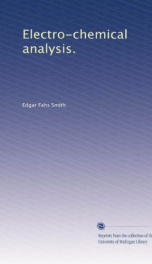electro analysis

Purchase of this book includes free trial access to www.million-books.com where you can read more than a million books for free. This is an OCR edition with typos. Excerpt from book: room, has a very neat and finished appearance. (Science, X3 697 (1901).) The following references may also be consulted: Z. f. Elektrochem., 8, 398, 445; 9, 496; 10, 238. H. Nissenson, Einrichtungen von elektrolytischen Laboratorien, etc. V e r 1 a g von W. Knapp in Halle a. S. Elektrochemische Zeitschrift 10, 267; Gazzetta chimica italiana, 36, 401 ; Abegg, Z. f. Elektrochem., 12, 109; Foerster, ibid., 12, 183. Before taking up the description of the details to be observed in the electrolytic precipitation of individual metals, it may not be uninteresting to briefly trace the history of the introduction of the electric current into chemical analysis. 4. HISTORICAL. Although the early years of last century show considerable activity in electrical studies, the efforts were mainly directed to the solution of the physical side of electrolysis. Cruikshank (1801), observing the readiness with which the metal copper was precipitated by the current, first suggested it as a possible agent in the detection of metals. Fischer (1812) detected arsenic, and Cozzi (1840) the metals generally in animal fluids by this means, while Gaul- tier de Claubry (1850) directed his efforts wholly to the isolation of metals from poisons by depositing the same upon plates of platinum. When the precipitation was considered finished the plates were removed, carefully washed, and the deposited metals brought into solution with nitric acid, and there tested for and identified by the usual course of analysis. The current was evidently very feeble, as the time recorded as necessary for the deposition varied from ten to twelve hours. Gaultier considered this method reliable in all instances, but especially recommends it for theseparation of copper from bread. In testing for zinc he employed a strip of t...
Info about the book
Author:
Series:
Unknown
ISBN:
1112246592
Rating:
4.5/5 (2)Your rating:
0/5
Languge:
English
Users who have this book
Users who want this book
What readers are saying
What do you think? Write your own comment on this book!
write a commentGenre
if you like electro analysis try:
Do you want to read a book that interests you? It’s EASY!
Create an account and send a request for reading to other users on the Webpage of the book!








